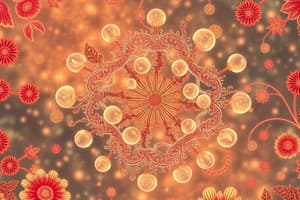Podcast
Questions and Answers
¿Cuál es la función principal de las mitocondrias en las células?
¿Cuál es la función principal de las mitocondrias en las células?
- Producción de energía (correct)
- Almacenamiento de nutrientes
- División celular
- Fotosíntesis
¿Cómo se llama la estructura plegada en la membrana interna de las mitocondrias donde residen las cadenas de transporte de electrones?
¿Cómo se llama la estructura plegada en la membrana interna de las mitocondrias donde residen las cadenas de transporte de electrones?
- Vacuolas
- Ribosomas
- Lisosomas
- Cristae (correct)
¿Cuál es la principal función de las mitocondrias durante la respiración celular?
¿Cuál es la principal función de las mitocondrias durante la respiración celular?
- Sintetizar carbohidratos
- Capturar luz solar para producir energía
- Generar ATP mediante fosforilación oxidativa (correct)
- Producir proteínas
¿Cuál es la función de las proteínas presentes en la membrana interna de las mitocondrias?
¿Cuál es la función de las proteínas presentes en la membrana interna de las mitocondrias?
¿Cuál es una característica distintiva de las mitocondrias en comparación con otras organelas celulares?
¿Cuál es una característica distintiva de las mitocondrias en comparación con otras organelas celulares?
¿Qué parte de las células contienen principalmente las mitocondrias?
¿Qué parte de las células contienen principalmente las mitocondrias?
¿Cuál es el rol principal de las mitocondrias mencionado en el texto?
¿Cuál es el rol principal de las mitocondrias mencionado en el texto?
¿Cuál es una función crucial de las mitocondrias que contribuye a la homeostasis celular?
¿Cuál es una función crucial de las mitocondrias que contribuye a la homeostasis celular?
¿En qué etapa ocurre la síntesis de ATP durante la respiración celular?
¿En qué etapa ocurre la síntesis de ATP durante la respiración celular?
¿Qué papel desempeñan las mitocondrias en la respiración celular?
¿Qué papel desempeñan las mitocondrias en la respiración celular?
¿Qué proceso es esencial para la producción eficiente de ATP durante la respiración celular?
¿Qué proceso es esencial para la producción eficiente de ATP durante la respiración celular?
¿Por qué las mitocondrias son consideradas organelos multifuncionales?
¿Por qué las mitocondrias son consideradas organelos multifuncionales?
Flashcards are hidden until you start studying
Study Notes
Mitochondria: Powerhouses of Cells
Mitochondria are tiny organelles within our cells, often referred to as the “powerhouse” due to their essential role in energy production. They're found primarily in animal cells and some plant cells, especially those involved in photosynthesis. Let's delve into this unique aspect of biology, exploring mitochondrial structure, function, and their critical part in cellular respiration.
Structure
A typical human cell contains several hundred mitochondria; each one measures between five and ten micrometers in length, roughly comparable to the size of bacteria. Their shape varies from spherical (round) to elongated filaments called cristae.
The inner membrane of mitochondria is folded, creating structures known as cristae—the site where electron transport chains reside. This intricate architecture greatly increases surface area, maximizing the efficiency of ATP generation via oxidative phosphorylation during cellular respiration.
Furthermore, the mitochondrion consists of two compartments divided by its outer membrane—an intermembrane space and the internal matrix. The inner membrane also holds numerous proteins involved with the transfer of electrons and energy required to generate ATP through oxidative phosphorylation.
Function
Mitochondria carry out various functions crucial to life, including cellular respiration, calcium storage and release, apoptosis (programmed cell death), regulation of cell growth, and heat production in thermogenic tissues such as brown fat. However, we focus here on the primary role of mitochondria: converting chemical energy stored in nutrients into ATP, which serves as our body's universal source of energy that fuels all cells.
This process occurs through four stages: glycolysis, pyruvate decarboxylation (citric acid cycle or TCA cycle), electron transport chain, and chemiosmosis—which culminates in ATP synthesis. Each stage relies heavily upon mitochondrial machinery, highlighting the importance of these organelles in maintaining cellular homeostasis.
Cellular Respiration
Cellular respiration represents the stepwise breakdown of substrates like glucose to produce ATP, more efficiently using molecular oxygen as the final electron acceptor. It comprises three main phases: glycolysis, citric acid cycle, and cellular respiratory electron transport chain that includes both oxidative phosphorylation and chemiosmosis.
In these processes, mitochondria play pivotal roles. For instance, they harbor enzymes for glycolysis and the TCA cycle while utilizing the electron transport chain to create proton gradients across the inner membrane that ultimately drive ATP synthesis via chemiosmosis. Thus, without mitochondria, cellular respiration would grind to a halt, leaving us unable to meet our basic metabolic demands.
In summary, mitochondria are dynamic, multifunctional organelles that contribute significantly to our overall health. By understanding their structure, function, and involvement in cellular respiration, we gain further appreciation for the incredible complexity of living systems.
Confidence: 95%
Studying That Suits You
Use AI to generate personalized quizzes and flashcards to suit your learning preferences.




